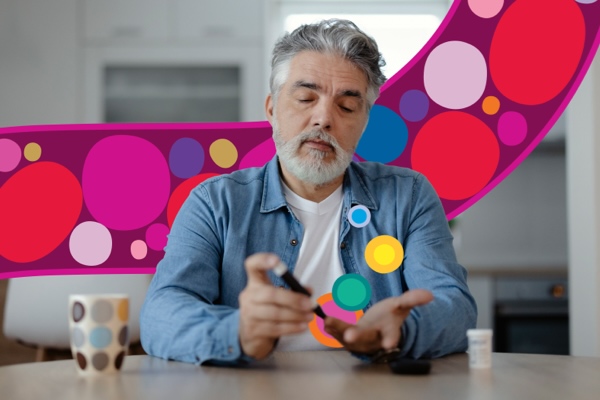Written by Medibank
March 2025
If you’ve been diagnosed with type 2 diabetes, there are lots of ways you can slow its progression and manage the risk of future complications. Lifestyle changes like getting active and eating more healthily can make a significant difference.
Here are some tips to help you manage your condition.

1. Embracing exercise with diabetes
Exercise is one of the best ways to control your blood glucose levels, keep your heart healthy, and improve your overall health and wellbeing. Aim for 2.5 to 5 hours of moderate activity or 1.25 to 2.5 hours of vigorous activity every week. If you are new to exercise, consult your GP before you start and make sure to take it slowly at first and build up your fitness over time.
One good way to increase your activity is to set short-term goals. As you achieve each goal, you can make the next one a little harder. Take a few minutes each week to note down what you’re doing in a diary or smart phone app to track your progress.
If you’re overweight, losing 5-10% of your bodyweight can make a real difference to how well you manage your blood glucose levels. It can also improve your blood pressure and cholesterol. Talk to your GP for help.
Medibank’s Live Better activities has some fun and free ideas for keeping your body active, both at home and outdoors.
2. Find foods that people with diabetes can eat freely
Aim to eat a wide variety of vegetables, fruits and whole grains, as well as reduced-fat dairy and proteins such as lean meat, eggs, tofu, nuts, seeds, legumes and beans. The Australian Dietary Guidelines are a great place to start, and your GP can refer you to a dietitian to help you develop a nutrition plan for your specific needs.
Processed food and drinks tend to have lots of added sugar or salt – you don’t have to cut them out completely but keep them as an occasional treat. Try stocking your freezer with healthy meals you can prepare quickly. When it comes to drinking, keep your alcohol intake to less than 10 standard drinks per week, and no more than 4 standard drinks in one day.
Timing is also important: space your meals at regular intervals through the day. This will help keep your blood glucose levels at a consistent level so that you don’t experience symptoms that occur when they dip or spike.
3. Get support to quit smoking
Diabetes increases your risk of heart disease, and smoking increases this risk even more. If you smoke, contact Quitline or talk to your GP.

Medibank Type 2 Diabetes Program
This 12-month program includes consultations with a dietitian and a supported meal plan that aims to help eligible members achieve a healthy weight and manage their type 2 diabetes. Clinical and product eligibility criteria apply.
4. Create a diabetes management plan
Your GP is the best place to start to get support managing your diabetes. There’s also good evidence to show that support from a dietitian or diabetes educator can help with weight loss and overall quality of life, and reduce the risk of complications. Talk to your GP or get in touch with Diabetes Australia for a referral.
If you’re an eligible Medibank hospital member*, you may also be able to access the Medibank Type 2 Diabetes Program. The program includes up to 10 video consultations with an accredited practicing dietitian to help with weight loss and diabetes management.
5. Monitor your blood glucose levels
One of the most important parts of type 2 diabetes management is keeping your blood glucose (sugar) levels within a certain range. Regular blood glucose level monitoring can help you see the effects of things like food and exercise, and help you to manage your levels, too. Speak to your GP to learn more.

24/7 Medibank Mental Health Support
Medibank health insurance members can talk with a mental health professional over the phone or online in relation to any mental health or emotional concern at no extra cost.* Chat 24 hours a day, 7 days a week on 1800 644 325 or log in to My Medibank.
* Some referred services may involve out of pocket costs and waiting periods may apply.
Read more about type 2 diabetes
Looking for something else?
Visit our type 2 diabetes hub for more information.
Things you need to know
* Available, where clinically appropriate, to Medibank members aged 18 or over with hospital cover that includes diabetes management who have been diagnosed with type 2 diabetes, are above a healthy weight (BMI≥25), can speak and read English and can access a telephone and internet.
While we hope you find this information helpful, please note that it is general in nature. It is not health advice, and is not tailored to meet your individual health needs. You should always consult a trusted health professional before making decisions about your health care. While we have prepared the information carefully, we can’t guarantee that it is accurate, complete or up-to-date. And while we may mention goods or services provided by others, we aren’t specifically endorsing them and can’t accept responsibility for them. For these reasons we are unable to accept responsibility for any loss that may be sustained from acting on this information (subject to applicable consumer guarantees).












